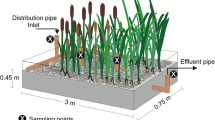Abstract
Two free water surface (FWS) and two subsurface flow (SSF) pilot-size wetlands were constructed for the evaluation of their performance in treating highway runoff (HRO) in the heart of the Mediterranean region, the island of Crete, at the southernmost point of Greece. Detailed recordings of the resources involved during the construction allowed a thorough calculation of the cost of the systems and the requirements in materials, man-hours, and equipment. The two identical FWS systems had a surface area of 33 m2 each, while the two identical SSF covered 32 m2 each. One FWS and one SSF, named FWS12 and SSF12, respectively, were designed with a hydraulic retention time (HRT) of 12 h, with each one capable of treating a maximum HRO of 12.6 m3/day. The other couple, named FWS24 and SSF24, respectively, was designed with an HRT of 24 h, with each receiving a maximum HRO of 6.3 m3/days. An influent storage tank was required to hold the runoff during the common storm events and control the flow rate (and the hydraulic retention time) into the wetlands. This construction represented 25% of the total construction cost, while 5% was spent on the influent automated (and sun-powered) control and distribution system, from the storage tank to the wetlands. The respective total cost allocated to the two SSF systems (€14,676) was approximately 10% higher than that of the FWS (€13,596), mainly due to the three different-sized gravel layers used in the SSF substrate compared to the topsoil used in the FWS, which tripled the cost and placement time. The Total Annual Economic Cost (TAEC) was €1799/year and €1847/year for the FWS and SSF pair, respectively. TAEC was also used to compare the economic efficiency of the systems per cubic meter of HRO treated and kilograms of COD and TSS removed from the wetlands during their first operational year. Based on these estimations, FWS12 recorded the lowest TAECCOD and TAECTSS values (€89.09/kg and €43.69/kg, respectively) compared to the other three systems, presenting a more economically favorable option.


Similar content being viewed by others
References
Boutin C, Lienard A, Ramain JL, Beyeler L (1993) Experimental plants for very small communities: choice and design criteria for five different processes. Water Science and Technology 28(10):6–9
Crites R, Tchobanoglous G (1998) Small and decentralised wastewater management systems. WCB and McGraw-Hill, New York
Dialynas G, Kefalakis N, Dialynas M, Angelakis A (2002) Performance of an innovative FWS constructed wetland in Crete, Greece. Water Science and Technology 46(4–5):355–360
Kokosalis M (2007) Constructed wetlands as an option for Cretan communities and municipalities wastewater problem. Master’s Thesis. Greek Open University (in Greek)
Manios T, Albantakis D, Zarmakoupis A, Sabathianakis I, Karathanasis AD (2007) Constructed wetlands for highway runoff treatment in the central Mediterranean region, part I: Operating parameters. International conference on environmental management, engineering, planning and economics (CEMEPE2007), June 24–28, 2007, Skiathos, Greece
Reed SC (1991) Constructed wetlands for waste-water treatment. Biocycle 32:44–49
Reed SC, Parten S, Matzen G, Randy P (1996) Water reuse for sludge management and wetland habitat. Water Science and Technology 33(10–11):213–219
Scholz M, Xu J, Dodson HI (2001) Comparison of filter media, plant communities and microbiology within constructed wetlands treating wastewater containing heavy metals. Journal of Chemical Technology and Biotechnology 76:827–835
Shutes RBE, Revitt DM, Mungur AS, Scholes LNL (1997) The design of wetland systems for the treatment of urban runoff. Water Science and Technology 35(5):19–25
Shutes RBE, Revitt DM, Lageberg IM, Barraud VCE (1999) The design of vegetated constructed wetlands for the treatment of highway runoff. The Science of the Total Environment 235:187–189
Soderqvist T (2002) Constructed wetlands as nitrogen sinks in southern Sweden: an empirical analysis of cost determinants. Ecological Engineering 19:161–173
Tchobanoglous G, Burton FL (1991) Wastewater engineering treatment disposal and reuse. McGraw–Hill, New York
Terzakis S, Fountoulakis M, Georgaki I, Albantakis D, Sabathianakis I, Karathanasis D, Kalogerakis N, Manios T (2007) Constructed wetlands for highway runoff treatment in the central Mediterranean region. Chemosphere 72:141–149
Tsagarakis KP, Mara DD, Angelakis AN (2003) Application of cost criteria for selection of municipal wastewater treatment systems. Water, Air, and Soil Pollution 142:187–210
Tsihrintzis VA, Akratos CS, Gikas GD, Karamouz D, Angelakis AN (2007) Performance, and cost comparison of a FWS and a VSF constructed wetland system. Environmental Technology 28:621–628
USEPA (2002) Constructed wetlands and aquatic plant systems for municipal wastewater treatment. Design manual. U.S. Environmental Protection Agency, Cincinnati, OH
Weiss PT, Gulliver JS, Erickson AJ (2007) Cost and pollutant removal of storm-water treatment practices. ASCE: Journal of Water Resources Planning and Management 133:218–229
Acknowledgments
This research was funded by the Greek General Secretariat for Research and Technology and Environmental Engineering S.A. The authors would like to thank George Melabiakanis, Vaggelis Makridakis, and George Hatziemmanouil for their help and involvement in the completion of the project. Special thanks go to the Municipality of Hersonissos and Mayor Mr. Spiros Danelis for provision of the field for the construction of the wetlands, as well as for their overall contribution to the completion of the project.
Author information
Authors and Affiliations
Corresponding author
Rights and permissions
About this article
Cite this article
Manios, T., Fountoulakis, M.S. & Karathanasis, A.D. Construction Simplicity and Cost as Selection Criteria Between Two Types of Constructed Wetlands Treating Highway Runoff. Environmental Management 43, 908–920 (2009). https://doi.org/10.1007/s00267-008-9250-z
Received:
Revised:
Accepted:
Published:
Issue Date:
DOI: https://doi.org/10.1007/s00267-008-9250-z




